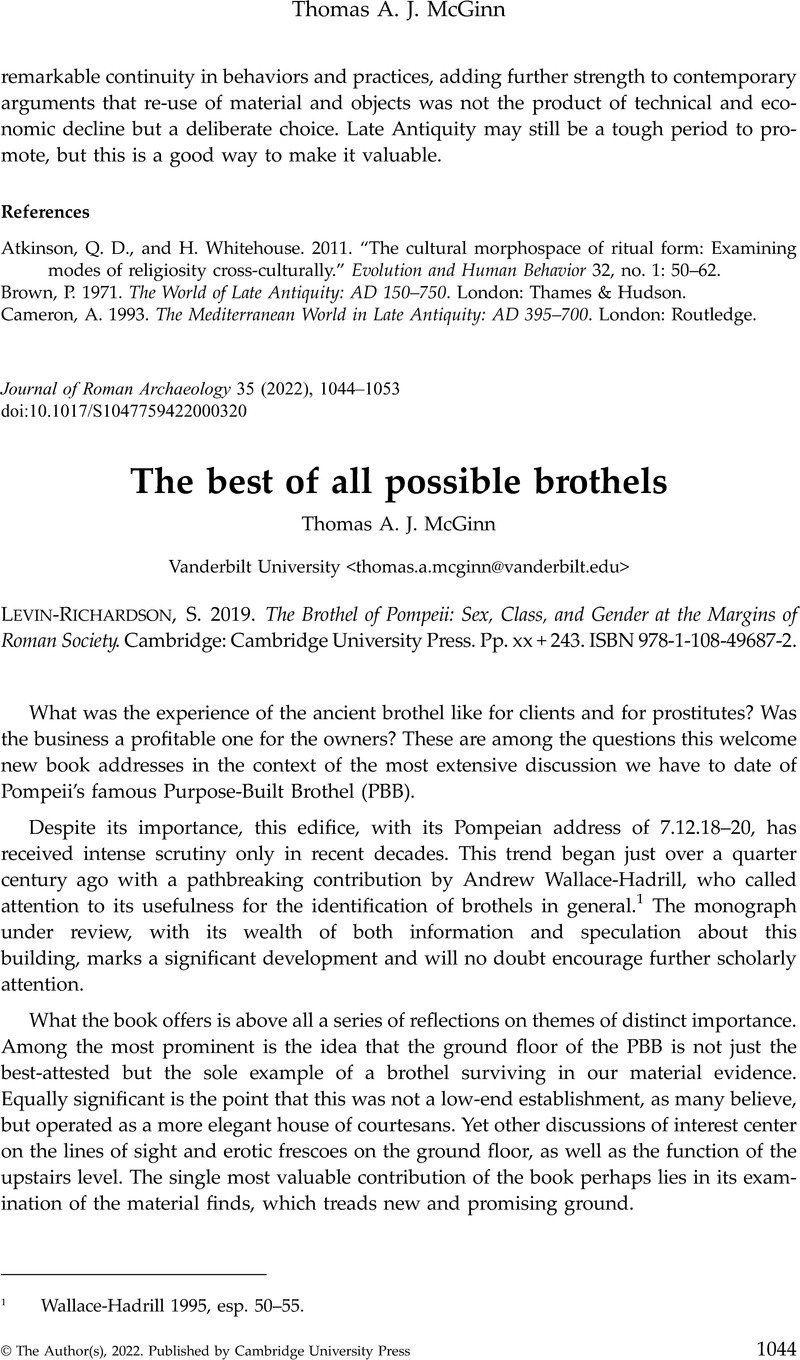No CrossRef data available.
Article contents
The best of all possible brothels - S. Levin-Richardson 2019. The Brothel of Pompeii: Sex, Class, and Gender at the Margins of Roman Society. Cambridge: Cambridge University Press. Pp. xx + 243. ISBN 978-1-108-49687-2.
Review products
S. Levin-Richardson 2019. The Brothel of Pompeii: Sex, Class, and Gender at the Margins of Roman Society. Cambridge: Cambridge University Press. Pp. xx + 243. ISBN 978-1-108-49687-2.
Published online by Cambridge University Press: 26 September 2022
Abstract
An abstract is not available for this content so a preview has been provided. Please use the Get access link above for information on how to access this content.

- Type
- Book Review
- Information
- Copyright
- Copyright © The Author(s), 2022. Published by Cambridge University Press
References
Berg, R., and Neudecker, R., eds. 2018. The Roman Courtesan: Archaeological Reflections of a Literary Topos. Rome: Institutum Romanum Finlandiae.Google Scholar
Bodel, J. 2015. “Inscriptions and literacy.” In The Oxford Handbook of Roman Epigraphy, ed. Bruun, C. and Edmondson, J., 745–63. Oxford: Oxford University Press.Google Scholar
Clarke, J. R. 1998. Looking at Lovemaking: Constructions of Sexuality in Roman Art, 100 B.C. - A.D. 250. Berkeley: University of California Press.CrossRefGoogle Scholar
Dunbabin, K. M. D. 2003. The Roman Banquet: Images of Conviviality. Cambridge: Cambridge University Press.Google Scholar
Fiorelli, G. 1862. Giornale degli scavi di Pompei. Naples: Stamperia della R. Università.Google Scholar
Jacobelli, L. 2001. “Pompei città di Venere.” In Louis Barré: Museo segreto 1, ed. García, L. y García, L. Jacobelli, , 27–53. Pompei: Marius Edizioni.Google Scholar
Levin-Richardson, S. 2011. “Facilis hic futuit: Graffiti and masculinity in Pompeii's ‘Purpose-Built’ Brothel.” Helios 38, no. 1: 59–78.CrossRefGoogle Scholar
McGinn, T. A. J. 1998. Prostitution, Sexuality, and the Law in Ancient Rome. New York: Oxford University Press.Google Scholar
McGinn, T. A. J. 2004. The Economy of Prostitution in the Roman World: A Study of Social History and the Brothel. Ann Arbor, MI: University of Michigan Press.CrossRefGoogle Scholar
Wallace-Hadrill, A. 1994. Houses and Society in Pompeii and Herculaneum. Princeton: Princeton University Press.CrossRefGoogle Scholar
Wallace-Hadrill, A. 1995. “Public honour and private shame: The urban texture of Pompeii.” In Urban Society in Roman Italy, ed. Cornell, T. J. and Lomas, K., 39–62. London: Routledge.Google Scholar
Zajac, M. J. 2008. “Lessons from the Lupanar: Functional Design and Economic Operation of the Pompeian Purpose-Built Brothel.” M.A. diss., Arizona State University.Google Scholar




